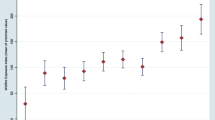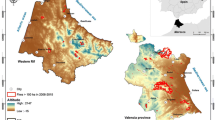Abstract
In many regions of the world, fires are primarily of anthropogenic origin. In northwestern Patagonia, the number of fires is not correlated with meteorological variables, but is concentrated in urban areas. This study was conducted in the wildland–urban interface (WUI) area of San Carlos de Bariloche (Patagonia, Argentina), within the Nahuel Huapi National Park. WUI fires are particularly problematic because, besides people and goods, they represent a danger to protected areas. We studied the relationship between fire records and socioeconomic indicators within the WUI of San Carlos de Bariloche. We conducted a Multiple Correspondence Factorial Analysis and an Ascendant Hierarchical Classification of the city neighborhoods. The results show that the neighborhoods in Bariloche can be divided into three classes: High Socioeconomic Fire Risk neighborhoods, including neighborhoods with the highest fire rates, where people have low instruction level, high levels of unsatisfied basic needs and high unemployment levels; Low Socioeconomic Fire Risk neighborhoods, that groups neighborhoods which present the opposite characterization, and Moderate Socioeconomic Fire Risk neighborhoods, which are more heterogeneous. Once neighborhoods were classified, a Socioeconomic Fire Risk map was generated, supplementing the existing WUI Fire Danger map. Our results emphasize the relevance of socioeconomic variables to fire policies.






Similar content being viewed by others
References
Abalerón CA (1993) Las transformaciones del espacio rural en el área periurbana: el caso de la periurbanización marginal en San carlos de Bariloche. Fundación Bariloche Thechnical Report 17, Bariloche
Abalerón CA (1995) Marginal urban space and unsatisfied basic need: the case of San Carlos de Bariloche, Argentina. Environment and Urbanization 7(1):97–115
Abalerón CA (2009) Desigualdades Socio-territoriales en la Patagonia Norte Argentina. Revista Líder 15:179–208
Bradstock RA, Gill AM, Kenny BJ, Scott J (1998) Bushfire risk at the urban interface estimated from historical weather records: consequences for the use of prescribed fire in the Sydney region of south-eastern Australia. Journal of Environmental Management 52:259–271
Brocklesby MA, Hinshelwood E (2001) Poverty and the environment: what the poor say. An assessment of Poverty-Environment Linkages in Participatory Poverty Assessments. Centre for Development Studies, University of Wales, Swansea
Butry D, Pye J, Prestemon J (2002) Prescribed fire in the interface: separating the people from the trees. In: Outcalt KW (ed) Proceedings of the eleventh biennial southern silvicultural research conference. General Technical Report SRS-48, Asheville. U.S. Department of Agriculture, Forest Service, Southern Research Station, pp 132–136
CAFRAP (2001) Comparison of areas burned in developed and undeveloped wild-land areas in the north-western Sierra Nevada foothills. California Department of Forestry and Fire Protection, Sacramento
Caracotche MS, Arosteguy C (2008) Problemas socio-institucionales respecto a los incendios forestales y de interfase en Patagonia norte: perspectivas desde la teoría social del riesgo. Facultad Latinoamericana de Ciencias Sociales—FLACSO Technical Report, Bariloche
Cardille JA, Ventura SJ, Turner MG (2001) Environmental and social factors influencing wildfires in the upper Midwest, United States. Ecological Applications 11(1):111–127
Chou YH, Minnich RA, Chase RA (1993) Mapping probability of fire occurrence in San Jacinto mountains, California, USA. Environmental Management 17(1):129–140
Chuvieco E, Aguado I, Yebra M, Nieto H, Salas J, Martín MP, Vilar L, Martínez J, Martín S, Ibarra P, de la Riva J, Baeza J, Rodríguez F, Molina JR, Herrera MA, Zamora R (2010) Development of a framework for fire risk assessment using remote sensing and geographic information system technologies. Ecological Modelling 221:46–58
Cohen J (2000) Preventing disaster: home ignitability in the wild-land–urban interface. Journal of Forestry 98(3):15–21
COTEPRIN (2002) Guía para la prevención de incendios de interfase en la República Argentina. Buenos Aires
Cutter SL (1996) Vulnerability to environmental hazards. Progress in Human Ecology 20(4):529–539
de Torres Curth MI, Ghermandi L, Pfister G (2008) Los incendios en el noroeste de la Patagonia: su relación con las condiciones meteorológicas y la presión antrópica a lo largo de 20 años. Ecología Austral 18:153–167
DECISIA (1996–2002) Centre International de Statistique et d’informatique apliquées. SPADN (Sistema portable para el análisis de datos numéricos) Version 5.5
Dentoni MC, Cerne SV (1999) La atmósfera y los incendios. Plan Nacional de Manejo del Fuego. Secretaría de Desarrollo Sustentable y Política Ambiental. Argentina
Dirección General de Estadísticas y Censos (2005) Censo Nacional de Población, Hogares y Viviendas 2001. Secretaría de Planificación y Control de Gestión. Dirección General de Estadística y Censos. Provincia de Río Negro, Argentina. http://www.estadistica.rionegro.gov.ar/. Accessed Sep 2010
Donoghue LR, Main WA (1985) Some factors influencing wildfire occurrence and measurement of fire prevention effectiveness. Journal of Environmental Management 20(1):87–96
Duncan BW, Schmalzer PA (2004) Anthropogenic influences on potential fire spread in a pyrogenic ecosystem of Florida, USA. Landscape Ecology 19(2):153–165
FAO (2005) Global Forest Resources Assessment 2005. Thematic report on forest fires in the South American Region. Forest Fire Management Working Paper 5. www.fao.org/forestry/site/fire-alerts/en. Accessed Sep 2010
Fried JS, Winter GJ, Gilless JK (1999) Assessing the benefits of reducing fire risk in the wild-land–urban interface: a contingent valuation approach. Journal of Wildland Fire 202(38):89–100
Gasparotto M (2002) Riesgo y producción social de peligro. El caso de los incendios forestales intencionales en San Carlos de Bariloche. Thesis, Universidad Nacional de Buenos Aires, Buenos Aires
Ghermandi L, de Torres Curth MI (2005) Los incendios en la Patagonia. I Workshop de Integración Regional Final Report, Bariloche
Haight RG, Cleland DT, Hammer RB, Radeloff VC, Rupp TS (2004) Assessing fire risk in the wild-land–urban interface. Journal of Forestry 104:41–48
Keeley JE (2005) Fire history of the San Francisco East Bay region and implications for landscape patterns. International Journal of Wildland Fire 14:285–296
Kitzberger T, Veblen TT (2002) Influences of climate on fire in northern Patagonia, Argentina. In: Veblen TT, Baker WL, Montenegro G, Swetnam TW (eds) Fire and climatic change in temperate ecosystems of the Western Americas. Springer, New York, pp 296–321
Lebart I, Morineau A, Pyron M (1995) Statistique Exploratoire Multidimensionnelle. Dunod, París
Leone V, Lovreglio R, Martinez-Fernandez J (2002) Forest fires and anthropic influences: a study case (Gargano National Park, Italy). In: Viegas X (ed) Forest fire research and wild-land fire safety. Mill Press, Rotterdam, pp 11–28
Leone V, Lovreglio R, Martín MP, Martínez JM, Vilar L (2009) Human factors of fire occurrence in the Mediterranean. In: Chuvieco E (ed) Earth observation of wildland fires in Mediterranean ecosystems. Springer, Berlin, pp 149–170
Macie EA, Hermansen LA (2002) Human influences on forest ecosystems. The Southern wild-land–urban interface assessment. US Department of Agriculture. Southern Research Station General Technical Report SRS-55. Southern Research Station, Asheville
Manta Nolasco MI (2007) Evaluación de las causas naturales y socioeconómicas de los incendios forestales en América del Sur. Proceedings of the 4th international wildfire conference, Seville, Spain, pp 1–17
Martell DL, Otukol S, Stocks BJ (1987) A logistic model for predicting daily people-cause forest fire occurrence in Ontario. Canadian Journal of Forest Research 17:394–401
Martínez J, Vega-Garcia C, Chuvieco E (2009) Human-caused wildfire risk rating for prevention planning in Spain. Journal of Environmental Management 90:1241–1252
McCaffrey SM (2004) Fighting fire with education. What is the best way to reach out to homeowners? Journal of Forestry 102(5):12–19
Mercer DE, Prestemon JP (2005) Comparing production function models for wildfire risk analysis in the wild-land–urban interface. Forest Policy and Economics 7:782–795
Mermoz M, Ubeda C, Grigera D, Brion C, Martín C, Bianchi E, Planas H (2009) El Parque Nacional Nahuel Huapi. Sus características ecológicas y estado de conservación. Editorial APN, PNNH, Bariloche
Naumann CM, Sancholuz LA (2000) Mapa de la vegetación del ejido de la ciudad de San Carlos de Bariloche. Revista de Geología Aplicada a la Ingeniería y al Ambiente 14:92–97
Niemi E, Lee K (2001) Wildfire and poverty. An overview of the interactions among wildfires, fire-related programs, and poverty in the western states. Portland State University, CWCH, Oregon
Pagès J (2004) Multiple factor analysis: main features and application to sensory data. Revista Colombiana de Estadística 27(1):1–26
Paruelo JM, Beltrán A, Jobbágy E, Sala OE, Golluscio RA (1998) The climate of Patagonia: general patterns and controls on biotic processes. Ecología Austral 8:85–101
Paveglio TV, Jakes PJ, Carroll MS, Williams DR (2009) Understanding social complexity within the wildland–urban interface: a new species of human habitation? Environmental Management 43:1085–1095
Piñol J, Terradas J, Lloret K (1998) Climate warming, wildfire hazard and wildfire occurrence in coastal eastern Spain. Climate Change 18:345–357
PNMF (2001–2005) Estadística de incendios forestales. www.ambiente.gov.ar. Accessed Sep 2010
Porrero Rodríguez MA (2001) Incendios Forestales. Investigación de causas. Mundi Prensa, Madrid
Radeloff VC, Hammer RB, Stewart SI, Fried JS, Holcomb SS, Mc Keefry JF (2005) The wild-land–urban interface in the United States. Ecological Applications 15(3):799–805
Sanchez-Guisandez M, Cui WB, Martell DL (2002) Fire smart management of flammable wild-land urban interface landscapes. In: Viegas DX (ed), Forest fire research and wild-land fire safety: proceedings of IV international conference on forest fire research 2002. Wild-land Fire Safety Summit, Luso, Coimbra, Portugal
Shindler B, Toman E (2003) Fuel reduction strategies in forest communities: a longitudinal analysis of public support. Journal of Forestry 101(6):8–15
SPLIF (2001–2005) Registros de Incendios Forestales del Servicio de Prevención y Lucha contra Incendios Forestales, Provincia de Río Negro
Syphard AD, Radeloff VC, Keeley JE, Hawbaker TJ, Clayton MK, Stewart SI, Hammer RB (2007) Human influence on California fire regimes. Ecological Applications 17(5):1388–1402
USDA (2001) Urban–wild-land interface communities within vicinity of federal lands that are at high risk from wildfire. Federal Register 66:751–777
Vega García C, Woodard PM, Titus SJ, Adamowicz WL, Lee BS (1999) Dos modelos para la predicción de Incendios en Whitecourt Forest, Canadá. Sistemas y Recursos Forestales 8(1):5–23
Winter G, Fried J (2000) Homeowner perspectives on fire hazard, responsibility and management strategies at the wild-land–urban interface. Society and Natural Resources 13:33–49
Winter G, Vogt C, Fried J (2002) Fuel treatments at the wildland–urban interface: common concerns in diverse regions. Journal of Forestry 100:15–21
Acknowledgments
We acknowledge constructive comments on an earlier version of three anonymous referees and Editors. We also thank Charlotte Reemts for the English corrections and comments on the manuscript. Financial support was provided by Universidad Nacional del Comahue (Project 04-B156) and CONICET. Also our thanks to J. Gowda, to the members of Plan Nacional de Manejo de Fuego and the SPLIF (Servicio de Prevención y Lucha contra Incendios Forestales), and to C. Carrá of Municipalidad de San Carlos de Bariloche.
Author information
Authors and Affiliations
Corresponding author
Rights and permissions
About this article
Cite this article
de Torres Curth, M., Biscayart, C., Ghermandi, L. et al. Wildland–Urban Interface Fires and Socioeconomic Conditions: A Case Study of a Northwestern Patagonia City. Environmental Management 49, 876–891 (2012). https://doi.org/10.1007/s00267-012-9825-6
Received:
Accepted:
Published:
Issue Date:
DOI: https://doi.org/10.1007/s00267-012-9825-6




